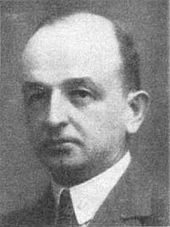Karl-Siegmund Litzmann
Karl-Siegmund Litzmann (born August 1, 1893 in Minden ; † August 1945 in Kappeln ) was Commissioner General for Estonia in the Reich Commissariat of Eastern Germany during the German occupation . The SA-Obergruppenführer officiated from December 5, 1941 to September 17, 1944 in Reval . Karl-Siegmund Litzmann was the son of the infantry general Karl Litzmann and the uncle of Walter Lehweß-Litzmann .
Life
Youth and First World War
In 1905 Litzmann attended a cadet institute and in 1911 was appointed Fahnenjunker . In November 1913, after completing the officer training course in Paderborn, he received his patent as a lieutenant . In November 1914 Litzmann and his unit , the Reserve Infantry Regiment No. 261, were trapped in the Lodz pocket, which was blown up under the command of his father, Lieutenant General Karl Litzmann at the head of the 3rd Guard Infantry Division . This event turned the war situation in favor of the German side. Litzmann was seriously wounded three times in the further course of the war. He received both classes of the Iron Cross and the Knight's Cross of the Royal House Order of Hohenzollern with Swords.
Weimar Republic
In 1919 Litzmann received an apprenticeship in agricultural management from the large landowner Carl Wentzel in Teutschenthal near Halle and in 1921 took over the administration of the Wentzel estate Althof-Didlacken near Insterburg in East Prussia.
In 1929 he joined the NSDAP and took over the establishment of the SA in East Prussia. From 1930 he was entrusted with the development of what would later become the Reiter-SA , which arose in 1933 from the incorporation of various parts of the horse breeding associations into the Sturmabteilung and their union with the SA units that had been mounted up until then, the SA Reiterstürmen. In 1931 he was appointed SA-Standartenführer and SA-Führer Ostland (East Prussia and Danzig).
Third Reich
In 1932 Litzmann moved into the Prussian state parliament for the NSDAP , after its dissolution on November 12, 1933, he became a permanent member of the German Reichstag .
In the summer of 1934, Litzmann, meanwhile with the rank of SA-Obergruppenführer, escaped the liquidation of the SA leadership (" Röhm-Putsch ") by the SS . He had received an order from Adolf Hitler to stay away from the leadership meeting of the SA on June 30, 1934. Hitler probably wanted to spare General Karl Litzmann, whom he held in high esteem (senior president of the Reichstag and Council of State), from murdering his son.
In 1934 Litzmann was appointed "Reichsreiterführer" and "Leader of the highest authorities for horse breeding and racing" in Berlin. The first tasks were to build the "Reichsreiterführer" school in Berlin-Zehlendorf and to prepare the team for the 1936 Olympics . In order to ensure a uniform training standard for all mounted units of the NS organizations (Reiter-SA and Reiter-HJ as well as formally the Reiter-SS ), the " National Socialist Riding Corps " was set up in March 1936 , the Litzmann as "Inspector of the SA riding schools " Board. In this function he was only responsible to the Chief of Staff of the SA .
Participation in World War II
In 1941 the publicly funded riding training was discontinued because it was no longer relevant for the SA and the Wehrmacht. Litzmann was now free for other tasks and was used as general commissioner for Estonia. This was in the Protectorate Ostland and had its seat in Reval . Out of consideration for Litzmann's wife, the Estonian administration was advised to use an "e" to make Litzmann Lietzmann in correspondence , since "Litz" ( Lits ) means " whore " in Estonian . Litzmann himself continued to sign his name correctly, however.
From 1944 he appeared as an officer in the Waffen SS . However, it is unclear whether Litzmann was posted there or volunteered. After the fighting in Hungary and the Czech Republic in the spring of 1945, he was considered missing.
death
Litzmann appeared in May 1945 under a false name in Kappeln (Schleswig-Holstein) with his sister who lived there, but died there under unexplained circumstances in August 1945. In spring 1946, the family property in Neuglobsow on Stechlinsee became under Soviet occupation as part of the land reform expropriated.
literature
- Bernd Nielsen-Stokkeby : Baltic memories. Estonia, Latvia, Lithuania between oppression and freedom , Bastei-Lübbe, Bergisch Gladbach 1990, p. 183, ISBN 3-7857-0583-2
- David Littlejohn: The SA 1921-45: Hitler's Stormtroopers , Osprey Publishing 1990, ISBN 978-0-85045-944-9
- Erich Stockhorst: 5000 people. Who was what in the 3rd Reich . Arndt, Kiel 2000, ISBN 3-88741-116-1 (unchanged reprint of the first edition from 1967).
Web links
- Karl-Siegmund Litzmann in the database of members of the Reichstag
| personal data | |
|---|---|
| SURNAME | Litzmann, Karl-Siegmund |
| BRIEF DESCRIPTION | German politician (NSDAP), MdR, MdL, General Commissioner for Estonia |
| DATE OF BIRTH | August 1, 1893 |
| PLACE OF BIRTH | Minden |
| DATE OF DEATH | August 1945 |
| Place of death | Kappeln |
